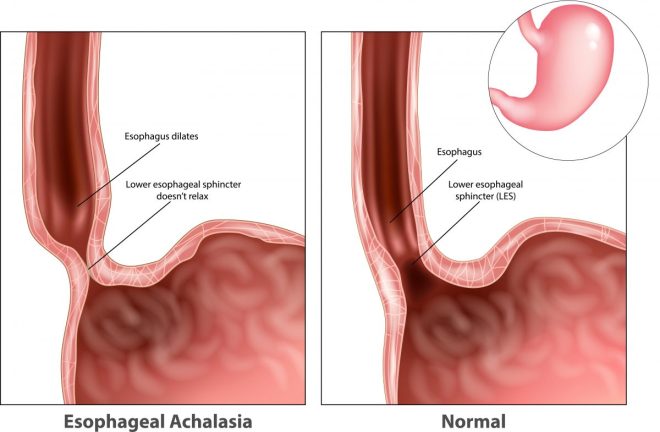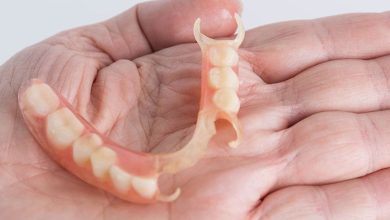

Achalasia is a serious condition that affects the esophagus. The esophagus is the tube that carries food from the throat to the stomach.
The lower esophageal sphincter (LES) is a muscular ring that closes off the esophagus from the stomach. If you have achalasia, your LES fails to open up during swallowing, which it’s supposed to do. This leads to a backup of food within your esophagus.
This condition can be related to damaged nerves in your esophagus. It can also be due to damage of the LES.
Achalasia usually occurs later in life, but it can also occur in children. Individuals who are middle-aged and older are at higher risk for the condition. Achalasia is also more common in people with autoimmune disorders.
People with achalasia will often have trouble swallowing or feel like food is stuck in their esophagus. This is also known as dysphagia.
Table of Contents
Symptoms of achalasia:
- pain or discomfort in your chest
- weight loss
- heartburn
- intense pain or discomfort after eating
Causes of achalasia:
Achalasia can happen for different reasons. It can be difficult for your doctor to find a specific cause. This condition may be hereditary, or it may be the result of an autoimmune condition.
With this type of condition, your body’s immune system mistakenly attacks healthy cells in your body. The degeneration of nerves in your esophagus often contributes to the advanced symptoms of achalasia.
Other conditions can cause symptoms similar to achalasia. Cancer of the esophagus is one of these conditions. Another cause is a rare parasitic infection called Chagas’ disease. This disease occurs mostly in South America.
Achalasia treatment
Most achalasia treatments involve your LES. Several types of treatment can either temporarily reduce your symptoms or permanently alter the function of the valve.
As a first-line therapy, your doctors can either dilate the sphincter or alter it. Pneumatic dilation typically involves inserting a balloon into your esophagus and inflating it. This stretches out the sphincter and helps your esophagus function better. However, sometimes dilation tears the sphincter. If this happens, you may need additional surgery to repair it.
Esophagomyotomy is a type of surgery that can help you if you have achalasia. Your doctor will use a large or small incision to access the sphincter and carefully alter it to allow better flow into the stomach. The great majority of esophagomyotomy procedures are successful.
However, some people have problems afterward with gastroesophageal reflux disease (GERD). If you have GERD, your stomach acid backs up into your esophagus. This can cause heartburn.
If you are unable to undergo pneumatic or surgical correction of your achalasia, your doctor might use Botox to relax the sphincter. Botox is injected into the sphincter through an endoscope.
If these options aren’t available or don’t work, nitrates or calcium channel blockers can help relax the sphincter so food can pass through it more easily.
How to diagnose achalasia
Your doctor might suspect you have achalasia if you have trouble swallowing both solids and liquids, particularly if it gets worse over time.
Your doctor may use esophageal manometry to diagnose achalasia. This involves placing a tube in your esophagus while you swallow. The tube records the muscle activity and makes sure your esophagus is functioning properly.
An X-ray or similar exam of your esophagus may also be helpful in diagnosing this condition. Other doctors prefer to perform an endoscopy. In this procedure, your doctor will insert a tube with a small camera on the end into your esophagus to look for problems.
Another diagnostic method is a barium swallow. If you have this test, you’ll swallow barium prepared in liquid form. Your doctor will then track the barium’s movement down your esophagus through X-rays.
For any important information please contact us Email GadgetsNg info@gadgetsng.com
[Button id="1"]




If some one desires expert view concerning blogging afterward i suggest him/her to pay
a visit this website, Keep up the pleasant job.
You’ve made some decent points there. I looked on the internet to find out more about the
issue and found most individuals will go along with your views on this website.
Great beat ! I would like to apprentice while you amend your site, how could i subscribe for
a blog website? The account aided me a acceptable deal. I had been tiny
bit acquainted of this your broadcast offered bright clear concept
Great beat ! I wish to apprentice whilst you amend your site, how could i subscribe for a weblog web site?
The account aided me a applicable deal. I had been tiny
bit acquainted of this your broadcast offered bright
transparent concept
I’m very happy to discover this website. I need to to thank you
for ones time for this wonderful read!! I definitely appreciated every little
bit of it and I have you saved to fav to see new information in your website.
I do not know whether it’s just me or if perhaps everyone
else experiencing issues with your website. It looks like some of
the written text on your content are running off
the screen. Can someone else please comment and let me know if this is happening to them as well?
This may be a problem with my internet browser because I’ve had this happen before.
Thank you
Please let me know if you’re looking for a writer for
your blog. You have some really good posts and I feel I would be a good asset.
If you ever want to take some of the load off,
I’d love to write some articles for your blog in exchange for
a link back to mine. Please send me an email if interested.
Cheers!
Hi there to every body, it’s my first pay a quick visit of this weblog; this website carries amazing and
in fact fine information designed for visitors.
Its like you read my mind! You appear to know a lot about this, like you wrote the book in it or something.
I think that you can do with some pics to drive the message home a
little bit, but instead of that, this is wonderful blog.
An excellent read. I will certainly be back.
I think this is one of the most significant info for me. And
i am glad reading your article. But should remark on few
general things, The web site style is perfect, the articles
is really nice : D. Good job, cheers
It’s remarkable to pay a visit this site and reading the views of all colleagues about this piece of writing, while I am also eager of getting familiarity.
Highly descriptive blog, I liked that bit. Will there
be a part 2?
Hi! Would you mind if I share your blog with my zynga group?
There’s a lot of people that I think would really appreciate your content.
Please let me know. Cheers
Thank you for another great post. The place else may just
anyone get that type of information in such a perfect manner of writing?
I’ve a presentation next week, and I am on the search for
such information.
What’s up to every , because I am really keen of reading this blog’s post to be updated on a regular basis.
It includes fastidious material.
Right here is the perfect website for anyone who
hopes to find out about this topic. You realize a
whole lot its almost hard to argue with you (not that I really will need
to…HaHa). You certainly put a fresh spin on a subject
which has been written about for decades. Great stuff, just excellent!
Usually I don’t learn post on blogs, however I would
like to say that this write-up very forced me to take a look at and do so!
Your writing taste has been amazed me. Thank you, very great post.
wonderful submit, very informative. I wonder why the opposite specialists of this sector
don’t understand this. You must continue your writing.
I am confident, you’ve a great readers’ base already!
My family all the time say that I am wasting my time here at net, however I know I am getting experience
all the time by reading such good posts.
Hi, Neat post. There’s a problem with your website in internet explorer, might
test this? IE still is the marketplace chief and a large part of folks will omit your wonderful writing because of this problem.
Great blog! Do you have any tips and hints for aspiring writers?
I’m hoping to start my own site soon but I’m a little lost on everything.
Would you recommend starting with a free platform like WordPress or
go for a paid option? There are so many options out there that I’m completely
confused .. Any tips? Thanks!
This is a really good tip particularly to those new to the blogosphere.
Brief but very accurate information… Thank you for sharing this one.
A must read article!
This article will help the internet visitors for
creating new blog or even a blog from start to end.
This design is wicked! You obviously know how to keep a reader
amused. Between your wit and your videos, I was almost
moved to start my own blog (well, almost…HaHa!) Fantastic job.
I really enjoyed what you had to say, and more than that, how you presented it.
Too cool!
Magnificent beat ! I wish to apprentice even as you amend
your web site, how could i subscribe for a blog website?
The account aided me a applicable deal. I were tiny bit familiar of
this your broadcast provided bright clear concept
Hello, the whole thing is going sound here and ofcourse every one is sharing information, that’s in fact good, keep
up writing.
These are really impressive ideas in about blogging.
You have touched some fastidious things here.
Any way keep up wrinting.
I’m gone to inform my little brother, that he should also visit this website on regular basis to take updated from latest
gossip.
This design is incredible! You definitely know how to keep a reader amused.
Between your wit and your videos, I was almost moved to start my own blog
(well, almost…HaHa!) Fantastic job. I really loved what
you had to say, and more than that, how you presented it. Too cool!
Oh my goodness! Amazing article dude! Thank you so much, However
I am encountering troubles with your RSS. I don’t understand why I can’t subscribe to
it. Is there anybody having the same RSS problems? Anyone who knows the answer can you kindly respond?
Thanx!!
Awesome! Its actually amazing paragraph, I have got much clear idea
regarding from this article.